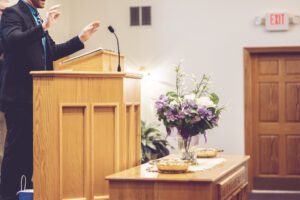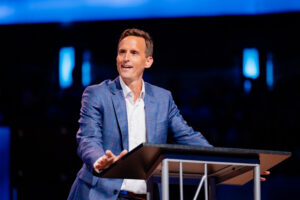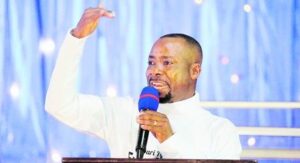
FORT WORTH, Texas (BP)–A new television special produced by the North American Mission Board’s broadcast communications group examines in detail the Sept. 15, 1999, shootings at Wedgwood Baptist Church in Fort Worth — and the inspiring testimonies of the survivors.
Titled ” … and a time to heal,” the one-hour documentary will be released Sept. 10 to ABC network affiliates nationwide. Individual stations will determine local air dates and times.
NAMB produces two television programs each year for network distribution as part of the Interfaith Broadcast Commission, but the Wedgwood special differs in its intense emotional impact — as well as the personal involvement of several NAMB staffers who also are members of Wedgwood.
One of those is Martin Coleman, author of the script and director of NAMB’s production team. Coleman arrived at the church alongside emergency vehicles to find his family had missed being at the scene of the shootings by only a few minutes. Larry Gene Ashbrook shot seven individuals and wounded seven others that evening before he took his own life.
“There was what I would describe as orderly chaos, as people tried to put pieces together and make sense out of what had just happened. And yet, as people began to be interviewed, I kept hearing over and over that Christ would be glorified through this tragedy,” Coleman said in an interview.
“Having the benefit of knowing my family was safe, I watched in amazement that night — grieving for the dead and wounded, sad for our church’s lost innocence, yet sensing God’s presence in the aftermath and thinking, ‘Something important has happened here tonight.'”
The documentary begins with a minute-by-minute account of the shooting from the witnesses themselves, beginning with Ashbrook’s arrival on the property and continuing through the immediate aftermath.
It also describes how one young man, Jeremiah Nietz, got off the floor and into a pew during the shootings and began praying. Seven people had been killed, and those on the scene feared a row-by-row massacre of everyone in the sanctuary. But when confronted by the shooter, Nietz boldly told him, “What you need is Jesus Christ in your life.”
“He pointed the gun at me and I stood up and put my hands in the air,” Neitz says in the special. “I said, ‘You can shoot me if you want, but I’m going to heaven. How about you?'”
“And he [Ashbrook] just looked at me and said something like, ‘Shut up.'” Neitz continued. “Then he looked at me again, and then his face just went white.” Ashbrook shot himself immediately after that.
“I don’t think it was me doing it,” the young man said. “… It might have been God working through me, but it wasn’t me.”
Similar anecdotes of God’s faithfulness throughout the tragedy permeate the program, from the stories of the faithfulness of the victims to the messages scrawled by friends on the bare concrete floor before new carpet went down in the sanctuary. And family members and friends share their own struggles and sources of strength. As pastor Al Meredith described it, the common question was, “Where was God in all of this?”
“The answer God gave me was he was right exactly where he was when his own dear Son suffered and died on Calvary’s cross,” said Meredith. “And he knows what it’s like to be a parent, to see a child die cruelly and unjustly. And his heart is broken with ours.”
Bernie Hargis, the program’s producer, said, “We’re hoping we can tell the story of how this church has gone through something that no other church has been through, certainly no church in recent history. They have experienced tragedy and violence, and yet they were not destroyed. If anything, they’ve come through it stronger than before.”
The program closes, in fact, with the father of one of the victims stating that worship in the sanctuary “continues to be a joy” despite occasionally being fixated on the spot of his daughter’ death. In the final segment, the congregation joins hands while singing “Holy Ground.”
Coleman noted that NAMB was ideally positioned to tell the powerful story of Wedgwood.
“An attack on any church would have outraged us as Christians, but this one happened to one of our own, and NAMB had the resources to help get the story out,” he said. “In doing so, NAMB has been able to assist Wedgwood in telling the nation that God loves us, no matter what we’re going through, and that we can have hope in any circumstance though a relationship with Jesus Christ.”
Coleman also acknowledged the emotional impact the project had on his own life.
“We interviewed more than 40 people for this program and I lived with the transcripts of those interviews, day and night, for nearly three weeks,” he said. “People were incredibly candid, in some cases relating experiences they had never shared before. There were many times when I had to put down papers and just cry for a while, partly because of what I was reading, but also out of grief for what had happened — to my friends, to my church, to my family. It was a purging of feelings I didn’t even know I had.”
Similarly, the program has also been cathartic for church members, serving as just one more stage of a grief process that Coleman said is still far from over.
“My Sunday School department has rallied around the program, covering the whole production in prayer,” he said. The deacons have prayed for it. Our staff has prayed for it. Everyone we asked for help has cooperated with a sense of urgency, to get the word out that our God is a loving god, even in the midst of tragic circumstances.”
For information on broadcast dates and times for “… a time to heal,” contact your local ABC affiliate.
–30–













